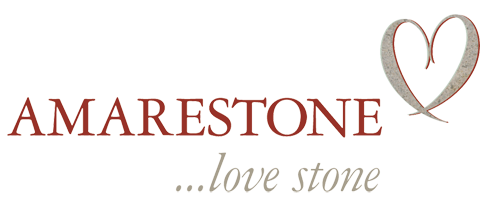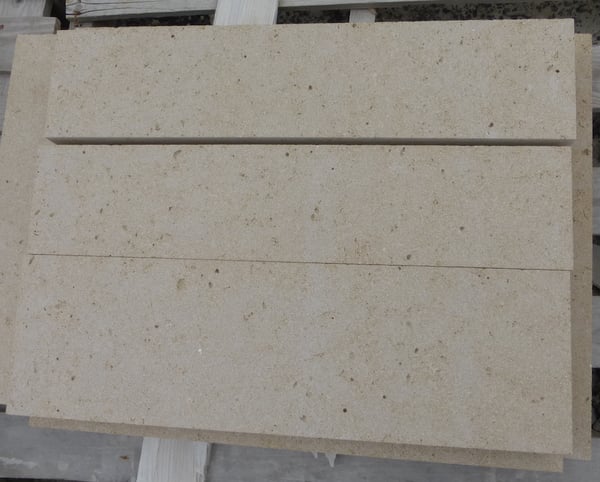Parisian Limestone
French limestone from the quarries by the river Oise to the north of Paris has been used for centuries to build the most recognised areas of the French capital city.
This stone, known also as "Lutetian Limestone" became synonymous with the famous sights of the Louvre, Notre Dame, Les Invalides, Place de La Concorde and many other iconic buildings and boulevards. The stone is a highly desirable building material for the rich and famous and it has been specified for many celebrity mansions across the world.


St Maximin French limestone
My first encounter with the famous Parisian limestone of St Maximin came when we were asked to recreate the chapel that Matisse designed in the hilltop town of Vence overlooking the Mediterranean on the Cote d'Azur.
The customer wanted to build his own private chapel in a barn in his garden in the style of Matisse's design. So, Denise and I travelled down to Vence in the south of France to have a close look at the Chapelle du Rosaire. We wanted to see which stone had been used for the flooring and for the altar. The flooring was easily identified as Italian marble, Carrara, with green slate cabochons but the altar stone took a bit more detective work. Fortunately, with our network of contacts throughout the French stone industry, it didn't take too long.
The stone for the altar of the Chapelle du Rosaire had been chosen by Matisse to resemble the texture and colour of bread. It has coarse grains with an open structure and is the colour of "pain de campagne" bread. The limestone from the St Maximin quarry north of Paris was the perfect stone to recreate Matisse's altar for our client in the UK.
The sample pieces we presented to the altar client had originally been cut as samples to show to the founder of Ebay when he was looking to build his new Las Vegas home.
St Maximin Quarry
St Maximin is probably the best known of the stone from the Oise region. There are lots of distinguishable benches (layers or "bancs" in French) in the St Maximin quarries including:
- Liais - the smallest bench but highly prized and suitable for flooring as well as for structural masonry pieces although the bench is relatively thin at around 500mm thick.
- Roche Fine - a finer grain and less open stone as used in the Champs Elysée
- Franche Fine - a beige stone with an open grained texture that can be used for structural pieces (and was used for our altar in the photo above).
- Franche Construction - a more open grained stone but still suitable for use as construction blocks or wall cladding
La Croix Huyart Lutetian limestone
Other Lutetian Limestone
Paris is not just built from stone from the St Maximin quarries. Other quarries in and around the Oise region have contributed to the Paris vernacular and these are also attracting buyers from around the world.
- La Croix Huyart - Dure and Demi-Dure benches. This stone is roughly similar in appearance and technical characteristics to the St Maximin Liais and Roche Fine benches. The Dure bench is, as the name suggests, the hardest and tightest grain and equates to the Liais bench. The Demi-Dure is slightly more granular and open in texture. It is closer in appearance to the St Maximin Roche Fine.
- St Leu - a pale, fine grained stone used in Versailles and Place Vendome
- Sebastopol - two main benches, the more coarse Construction grade and the other smaller grained Fine, this stone is often used as a budget option for one of the St Maximin benches.
- Noyant - a pale beige stone that is used for wall cladding and dimensional stone.
- Souppes - as used in the Arc de Triomphe. This stone is suitable for flooring, cladding and dimensional stone.
- Vassens - three distinct benches each offering great uniformity and different degrees of grain size. It is an excellent stone for cladding, fire surrounds, building blocks etc. Similar in appearance to the St Maximin Franche Fine and Franche Construction benches but more uniform in colour and texture. This stone has the added advantage of very tall bed heights.
 St Pierre Aigle - noticeably different from the above in that it is a white limestone with fossil shaped holes similar to the Portland Roach beds in the UK but much finer grained and denser. This is one of my favourite Paris limestones and can be very effective as a feature piece.
St Pierre Aigle - noticeably different from the above in that it is a white limestone with fossil shaped holes similar to the Portland Roach beds in the UK but much finer grained and denser. This is one of my favourite Paris limestones and can be very effective as a feature piece.
The building facades seen in Paris can often be a mix of different benches of St Maximin together with some of the other stones above.
Several of these limestones are very affordable as building stone in spite of them being in high demand for celebrity projects across the world.
Quarry Ownership
Several of the quarries have changed hands in the last year or so following the financial turmoil experienced by the largest and best known of the French quarry companies. It has been an uncertain time but the situation is settling down again now as new owners take over some of the established quarries. We are lucky enough to have good trading links with all the owners, new and old.
There are samples from all the Paris quarries (and from most of the other quarries in France) at our showroom on the outskirts of Reading, Berkshire. Drop in for a cup of coffee and look at the UK's widest range of French Limestone.
If you'd like to see what the world's "A list" celebrities find so appealing about the Paris limestones, call in to see us.
Visit our showroom:
Pudding Lane Nursery
Reading Road
Arborfield
Reading
Berkshire
RG2 9HP
If you have any other questions or need expert help with your natural stone project, please call us on 0345 260 80 70 or email steve@amarestone.com.
Thanks for reading.
Steve Turner
Amarestone
Tel: 0345 260 8070



